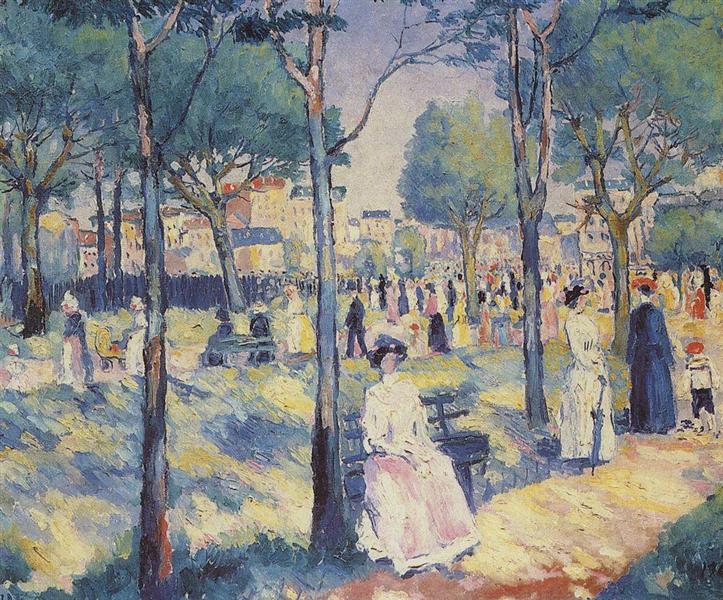Description
Kazimir Malevich, one of the most influential pioneers of abstract and founder of suprematism, presents in his work "on the boulevard" an intense exploration of urban perception through an avant -garde composition that captures the essence of a daily environment transformed through its particular artistic vision.
At first glance, "on the boulevard" reveals a series of human figures that roam so it seems to be an open space, possibly a square or a boulevard, as suggested by the title of the work. The figures, although discernible, are treated with almost geometric simplicity, a characteristic that Malevich adopted in its transition to suprematism, a movement that emphasizes basic geometric shapes and pure colors.
The use of color in this paint is particularly remarkable. Malevich uses a vivid and contrast colored palette, with a predominance of reds, orange and ocher, which stand out on a neutral background. This chromatic choice not only provides a vitality to the scene, but also highlights the individuality of each human figure without losing the cohesion of the set. The colors are applied in flat blocks, without evidencing the brush stroke, which reinforces the sensation of stability and architectural modernity within the chaos of urban life.
The figures in "on the boulevard" are immersed in individual dynamics, captured in different attitudes and directions, which suggests movement and activity in the space represented. This multiplicity of actions and positions invites the spectator to a detained observation, revealing a deep interest of Malevich in human interaction in public spaces, a subject appealed in many of his early works, before his full immersion in suprematism.
As for artistic composition, Malevich demonstrates a master's degree in the balance between forms and vacuum. The arrangement of the figures keep a harmony that avoids visual saturation, allowing the eye to move fluently between the different elements of the scene. This spatial management reminds its contemporaries of Cubism, although formal simplicity and deliberate depth suggest a more radical vision towards abstraction.
Kazimir Malevich, born in 1879, was an innovative in every way. Its artistic evolution from impressionism to cubofuturism and finally towards suprematism is a testimony of its incessant search for new forms of visual expression. This evolution process can be traced through works such as "on boulevard", which although it cannot be classified within pure suprematism, already denotes a clear inclination towards geometric abstraction and the conceptual use of color.
"On the boulevard" thus inserted into a broader context within Malevich's work, reflecting the concerns of an artist who not only observed his surroundings, but reinvented him. These schematic figures moving in a two -dimensional space can be interpreted as a prelude to its subsequent exploration of the supremacy of pure sensitivity, in which color and shape exist for themselves, free of any allusion to concrete reality.
Malevich's work, especially during the stage in which "on the boulevard" is located, is essential to understand the transition to modernism in art. This canvas not only offers a window to its creative process, but also reaffirms the relevance of its contribution to one of the most revolutionary times in the history of Western art. Each figure, each color and every shape in this painting is another step in its path to the redefinition of art as a purely spiritual and intellectual experience.
KUADROS ©, a famous paint on your wall.
Hand-made oil painting reproductions, with the quality of professional artists and the distinctive seal of KUADROS ©.
Art reproduction service with satisfaction guarantee. If you are not completely satisfied with the replica of your painting, we refund your money 100%.

